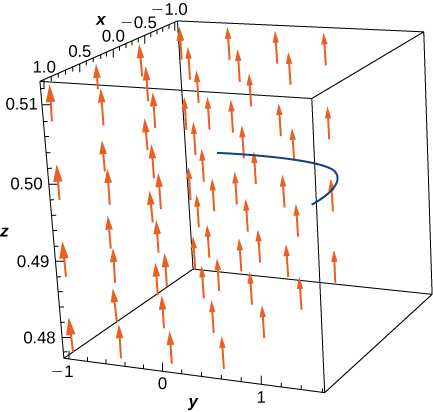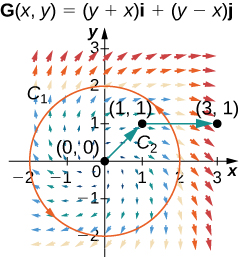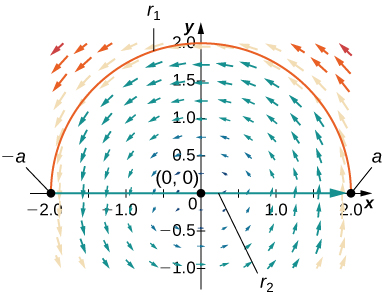16.3E : Exercices pour la section 16.3
- Page ID
- 197852
1. Vrai ou faux ? Si le champ vectoriel\(\vecs F\) est conservateur sur la région ouverte et connectée\(D\), les intégrales de ligne de\(\vecs F\) sont indépendantes du chemin\(D\), quelle que soit la forme de\(D\).
- Réponse
- Vrai
2. Vrai ou faux ? La fonction\(\vecs r(t)=\vecs a+t(\vecs b−\vecs a)\)\(0≤t≤1\), où, paramètre le segment de ligne droite de\(\vecs a\) à\(\vecs b\).
- Réponse
- Vrai
3. Vrai ou faux ? \(\vecs F(x,y,z)=(y\sin z)\,\mathbf{\hat i}+(x\sin z)\,\mathbf{\hat j}+(xy\cos z)\,\mathbf{\hat k}\)Le champ vectoriel est conservateur.
- Réponse
- Vrai
4. Vrai ou faux ? \(\vecs F(x,y,z)=y\,\mathbf{\hat i}+(x+z)\,\mathbf{\hat j}−y\,\mathbf{\hat k}\)Le champ vectoriel est conservateur.
5. Justifiez le théorème fondamental des intégrales linéaires\(\displaystyle \int _C\vecs F·d\vecs r\) dans le cas où\(\vecs{F}(x,y)=(2x+2y)\,\mathbf{\hat i}+(2x+2y)\,\mathbf{\hat j}\) et\(C\) est une partie du cercle orienté positivement\(x^2+y^2=25\) de\((5, 0)\) à\((3, 4).\)
- Réponse
- \(\displaystyle \int _C \vecs F·d\vecs r=24\)unités de travail
6. [T] Détermine\(\displaystyle \int _C\vecs F·d\vecs r,\) où\(\vecs{F}(x,y)=(ye^{xy}+\cos x)\,\mathbf{\hat i}+\left(xe^{xy}+\frac{1}{y^2+1}\right)\,\mathbf{\hat j}\) et\(C\) représente une portion de la courbe\(y=\sin x\) allant de\(x=0\) à\(x=\frac{π}{2}\).
7. [T] Évaluez l'intégrale de la ligne\(\displaystyle \int _C\vecs F·d\vecs r\)\(\vecs{F}(x,y)=(e^x\sin y−y)\,\mathbf{\hat i}+(e^x\cos y−x−2)\,\mathbf{\hat j}\), où et\(C\) est le chemin donné par\(\vecs r(t)=(t^3\sin\frac{πt}{2})\,\mathbf{\hat i}−(\frac{π}{2}\cos(\frac{πt}{2}+\frac{π}{2}))\,\mathbf{\hat j}\) for\(0≤t≤1\).

- Réponse
- \(\displaystyle \int _C\vecs F·d\vecs r=\left(e−\frac{3π}{2}\right)\)unités de travail
Pour les exercices suivants, déterminez si le champ vectoriel est conservateur et, dans l'affirmative, déterminez la fonction potentielle.
8. \(\vecs{F}(x,y)=2xy^3\,\mathbf{\hat i}+3y^2x^2\,\mathbf{\hat j}\)
9. \(\vecs{F}(x,y)=(−y+e^x\sin y)\,\mathbf{\hat i}+((x+2)e^x\cos y)\,\mathbf{\hat j}\)
- Réponse
- Pas conservateur
10. \(\vecs{F}(x,y)=(e^{2x}\sin y)\,\mathbf{\hat i}+(e^{2x}\cos y)\,\mathbf{\hat j}\)
11. \(\vecs{F}(x,y)=(6x+5y)\,\mathbf{\hat i}+(5x+4y)\,\mathbf{\hat j}\)
- Réponse
- Conservateur,\(f(x,y)=3x^2+5xy+2y^2+k\)
12. \(\vecs{F}(x,y)=(2x\cos(y)−y\cos(x))\,\mathbf{\hat i}+(−x^2\sin(y)−\sin(x))\,\mathbf{\hat j}\)
13. \(\vecs{F}(x,y)=(ye^x+\sin(y))\,\mathbf{\hat i}+(e^x+x\cos(y))\,\mathbf{\hat j}\)
- Réponse
- Conservateur,\(f(x,y)=ye^x+x\sin(y)+k\)
Pour les exercices suivants, évaluez les intégrales linéaires à l'aide du théorème fondamental des intégrales linéaires.
14. \(\displaystyle ∮_C(y\,\mathbf{\hat i}+x\,\mathbf{\hat j})·d\vecs r,\)où se\(C\) trouve n'importe quel chemin allant de\((0, 0)\) à\((2, 4)\)
15. \(\displaystyle ∮_C(2y\,dx+2x\,dy),\)où se\(C\) trouve le segment de ligne allant de\((0, 0)\) à\((4, 4)\)
- Réponse
- \(\displaystyle ∮_C(2y\,dx+2x\,dy)=32\)unités de travail
16. [T]\(\displaystyle ∮_C\left[\arctan\dfrac{y}{x}−\dfrac{xy}{x^2+y^2}\right]\,dx+\left[\dfrac{x^2}{x^2+y^2}+e^{−y}(1−y)\right]\,dy\), où se\(C\) trouve toute courbe lisse comprise entre\((1, 1)\) et\((−1,2).\)
17. Trouvez le champ vectoriel conservateur pour la fonction potentielle\(f(x,y)=5x^2+3xy+10y^2.\)
- Réponse
- \(\vecs{F}(x,y)=(10x+3y)\,\mathbf{\hat i}+(3x+20y)\,\mathbf{\hat j}\)
Pour les exercices suivants, déterminez si le champ vectoriel est conservateur et, dans l'affirmative, trouvez une fonction potentielle.
18. \(\vecs{F}(x,y)=(12xy)\,\mathbf{\hat i}+6(x^2+y^2)\,\mathbf{\hat j}\)
19. \(\vecs{F}(x,y)=(e^x\cos y)\,\mathbf{\hat i}+6(e^x\sin y)\,\mathbf{\hat j}\)
- Réponse
- \(\vecs F\)n'est pas conservateur.
20. \(\vecs{F}(x,y)=(2xye^{x^2y})\,\mathbf{\hat i}+6(x^2e^{x^2y})\,\mathbf{\hat j}\)
21. \(\vecs F(x,y,z)=(ye^z)\,\mathbf{\hat i}+(xe^z)\,\mathbf{\hat j}+(xye^z)\,\mathbf{\hat k}\)
- Réponse
- \(\vecs F\)est conservatrice et une fonction potentielle l'est\(f(x,y,z)=xye^z+k\).
22. \(\vecs F(x,y,z)=(\sin y)\,\mathbf{\hat i}−(x\cos y)\,\mathbf{\hat j}+\,\mathbf{\hat k}\)
23. \(\vecs F(x,y,z)=\dfrac{1}{y}\,\mathbf{\hat i}-\dfrac{x}{y^2}\,\mathbf{\hat j}+(2z−1)\,\mathbf{\hat k}\)
- Réponse
- \(\vecs F\)est conservatrice et une fonction potentielle est\(f(x,y,z)=\dfrac{x}{y}+z^2-z+k.\)
24. \(\vecs F(x,y,z)=3z^2\,\mathbf{\hat i}−\cos y\,\mathbf{\hat j}+2xz\,\mathbf{\hat k}\)
25. \(\vecs F(x,y,z)=(2xy)\,\mathbf{\hat i}+(x^2+2yz)\,\mathbf{\hat j}+y^2\,\mathbf{\hat k}\)
- Réponse
- \(\vecs F\)est conservatrice et une fonction potentielle est\(f(x,y,z)=x^2y+y^2z+k.\)
Pour les exercices suivants, déterminez si le champ vectoriel donné est conservateur et trouvez une fonction potentielle.
26. \(\vecs{F}(x,y)=(e^x\cos y)\,\mathbf{\hat i}+6(e^x\sin y)\,\mathbf{\hat j}\)
27. \(\vecs{F}(x,y)=(2xye^{x^2y})\,\mathbf{\hat i}+(x^2e^{x^2y})\,\mathbf{\hat j}\)
- Réponse
- \(\vecs F\)est conservatrice et une fonction potentielle est\(f(x,y)=e^{x^2y}+k\)
Pour les exercices suivants, évaluez l'intégrale à l'aide du théorème fondamental des intégrales linéaires.
28. Évaluez\(\displaystyle \int _C\vecs ∇f·d\vecs r\), où\(f(x,y,z)=\cos(πx)+\sin(πy)−xyz\) et où\(C\) se trouve tout chemin qui commence\((1,12,2)\) et se termine à\((2,1,−1)\).
29. [T] Évaluez\(\displaystyle \int _C\vecs ∇f·d\vecs r\), où\(f(x,y)=xy+e^x\) et\(C\) est une ligne droite allant de\((0,0)\) à\((2,1)\).
- Réponse
- \(\displaystyle \int _C\vecs F·d\vecs r=\left(e^2+1\right)\)unités de travail
30. [T] Évaluez\(\displaystyle \int _C\vecs ∇f·d\vecs r,\) où\(f(x,y)=x^2y−x\) et\(C\) se trouve n'importe quelle trajectoire dans un plan compris entre (1, 2) et (3, 2).
31. Évaluez\(\displaystyle \int _C\vecs ∇f·d\vecs r,\) où\(f(x,y,z)=xyz^2−yz\) et\(C\) a le point initial\((1, 2, 3)\) et le point terminal\((3, 5, 2).\)
- Réponse
- \(\displaystyle \int _C\vecs F·d\vecs r=38\)unités de travail
Pour les exercices suivants, soit\(\vecs{F}(x,y)=2xy^2\,\mathbf{\hat i}+(2yx^2+2y)\,\mathbf{\hat j}\) et\(G(x,y)=(y+x)\,\mathbf{\hat i}+(y−x)\,\mathbf{\hat j}\)\(C_1\) soit la courbe constituée du cercle de rayon 2, centré à l'origine et orienté dans le sens antihoraire, et\(C_2\) soit la courbe constituée d'un segment de droite allant de\((0, 0)\) à\((1, 1)\) suivi d'un segment de ligne allant de\((1, 1)\) à\((3, 1).\)

32. Calculez l'intégrale linéaire de\(\vecs F\) plus\(C_1\).
33. Calculez l'intégrale linéaire de\(\vecs G\) plus\(C_1\).
- Réponse
- \(\displaystyle ∮_{C_1}\vecs G·d\vecs r=−8π\)unités de travail
34. Calculez l'intégrale linéaire de\(\vecs F\) plus\(C_2\).
35. Calculez l'intégrale linéaire de\(\vecs G\) plus\(C_2\).
- Réponse
- \(\displaystyle ∮_{C_2}\vecs F·d\vecs r=7\)unités de travail
36. [T] Laissez\(\vecs F(x,y,z)=x^2\,\mathbf{\hat i}+z\sin(yz)\,\mathbf{\hat j}+y\sin(yz)\,\mathbf{\hat k}\). Calculez\(\displaystyle ∮_C\vecs F·d\vecs{r}\), où\(C\) se trouve un chemin allant de\(A=(0,0,1)\) à\(B=(3,1,2)\).
37. [T] Trouver l'intégrale linéaire\(\displaystyle ∮_C\vecs F·dr\) du champ vectoriel\(\vecs F(x,y,z)=3x^2z\,\mathbf{\hat i}+z^2\,\mathbf{\hat j}+(x^3+2yz)\,\mathbf{\hat k}\) le long de la courbe\(C\) paramétrée par\(\vecs r(t)=(\frac{\ln t}{\ln 2})\,\mathbf{\hat i}+t^{3/2}\,\mathbf{\hat j}+t\cos(πt),1≤t≤4.\)
- Réponse
- \(\displaystyle \int _C\vecs F·d\vecs r=150\)unités de travail
Pour les exercices 38 à 40, montrez que les champs vectoriels suivants sont conservateurs. Calculez ensuite\(\displaystyle \int _C\vecs F·d\vecs r\) pour la courbe donnée.
38. \(\vecs{F}(x,y)=(xy^2+3x^2y)\,\mathbf{\hat i}+(x+y)x^2\,\mathbf{\hat j}\);\(C\) est la courbe composée de segments de droite allant de\((1,1)\) à\((0,2)\) à\((3,0).\)
39. \(\vecs{F}(x,y)=\dfrac{2x}{y^2+1}\,\mathbf{\hat i}−\dfrac{2y(x^2+1)}{(y^2+1)^2}\,\mathbf{\hat j}\);\(C\) est paramétré par\(x=t^3−1,\;y=t^6−t\), pour\(0≤t≤1.\)
- Réponse
- \(\displaystyle \int _C\vecs F·d\vecs r=−1\)unités de travail
40. [T]\(\vecs{F}(x,y)=[\cos(xy^2)−xy^2\sin(xy^2)]\,\mathbf{\hat i}−2x^2y\sin(xy^2)\,\mathbf{\hat j}\) ;\(C\) est la courbe\(\langle e^t,e^{t+1}\rangle,\) de\(−1≤t≤0\).
41. La masse de la Terre est\(6×10^{27}g\) d'environ 330 000 fois celle du Soleil et 330 000 fois plus. La constante gravitationnelle est\(6.7×10^{−8}cm^3/s^2·g\). La distance entre la Terre et le Soleil est d'environ\(1.5×10^{12}cm\). Calculez, approximativement, le travail nécessaire pour augmenter la distance entre la Terre et le Soleil de\(1\;cm\).
- Réponse
- \(4×10^{31}\)erg
42. [T] Laissez\(\vecs{F}(x,y,z)=(e^x\sin y)\,\mathbf{\hat i}+(e^x\cos y)\,\mathbf{\hat j}+z^2\,\mathbf{\hat k}\). Évaluez l'intégrale\(\displaystyle \int _C\vecs F·d\vecs r\), où\(\vecs r(t)=\langle\sqrt{t},t^3,e^{\sqrt{t}}\rangle,\)\(0≤t≤1.\)
43. [T]\(C:[1,2]→ℝ^2\) Laissez-vous donner par\(x=e^{t−1},y=\sin\left(\frac{π}{t}\right)\). Utilisez un ordinateur pour calculer l'intégrale\(\displaystyle \int _C\vecs F·d\vecs r=\int _C 2x\cos y\,dx−x^2\sin y\,dy\), où\(\vecs{F}(x,y)=(2x\cos y)\,\mathbf{\hat i}−(x^2\sin y)\,\mathbf{\hat j}.\)
- Réponse
- \(\displaystyle \int _C\vecs F·d\vecs s=0.4687\)unités de travail
44. [T] Utilisez un système d'algèbre informatique pour déterminer la masse d'un fil qui se trouve le long de la courbe\(\vecs r(t)=(t^2−1)\,\mathbf{\hat j}+2t\,\mathbf{\hat k},\) où\(0≤t≤1\), si la densité est donnée par\(d(t) = \dfrac{3}{2}t\).
45. Déterminez la circulation et le flux du champ\(\vecs{F}(x,y)=−y\,\mathbf{\hat i}+x\,\mathbf{\hat j}\) autour et à travers le trajet semi-circulaire fermé qui consiste en un arc en plein cintre\(\vecs r_1(t)=(a\cos t)\,\mathbf{\hat i}+(a\sin t)\,\mathbf{\hat j},\quad 0≤t≤π\), suivi d'un segment de ligne\(\vecs r_2(t)=t\,\mathbf{\hat i},\quad −a≤t≤a.\)

- Réponse
- \(\text{circulation}=πa^2\)et\(\text{flux}=0\)
46. Calculez\(\displaystyle \int _C\cos x\cos y\,dx−\sin x\sin y\,dy,\) où\(\vecs r(t)=\langle t,t^2 \rangle, \quad 0≤t≤1.\)
47. Complétez la preuve du théorème intitulé THE PATH INDEPENDENCE TEST FOR CONSERVATIVE FIELDS en démontrant que\(f_y=Q(x,y).\)


